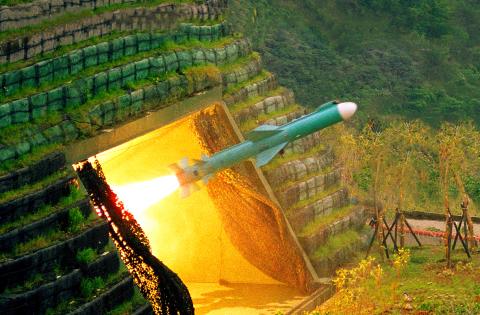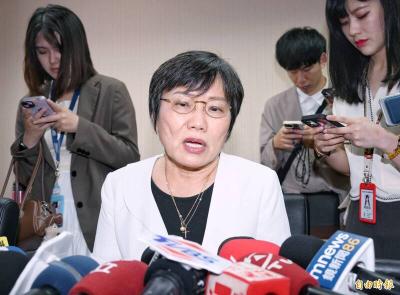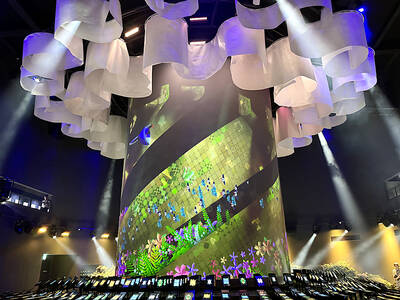Taiwan’s military could deploy surface-to-surface missiles on the Penghu Islands as part of efforts to mount a more credible deterrent capability against China, budgetary documents submitted earlier this month say.
According to the documents, the Ministry of National Defense’s Missile Command would deploy three missile squadrons at a fixed base on Penghu as part of a NT$2.5 billion (US$84.8 million) “Ji Zhun” (戟隼) plan for the acquisition of Hsiung Feng IIE (HF-2E) land attack cruise missiles. Part of the budget would reportedly be set aside for the construction of bunkers with dehumidifying systems to store the missiles.
President Ma Ying-jeou (馬英九) in 2008 gave the go-ahead for the production of 300 HF-2Es. The missile, developed by the Chung-Shan Institute of Science and Technology, was approved for full production earlier this year.

Photo: Military News Agency via CNA
The HF-2E can be fired from land-based emplacements as well as surface vessels. With an estimated range of 600km, the HF-2E brings some ports in southern China within range, which would now be extended by being deployed on Penghu, located in the middle of the Taiwan Strait.
HF-2Es have been spotted on naval vessels anchored at Penghu’s Makung (馬公) and Tien Kung II surface-to-air missiles are deployed there.
Stating standard procedure on military deployments, a Ministry of National Defense spokesman yesterday would not comment on the report, which first appeared in the Chinese-language United Daily News on Wednesday last week.
The amount of money to be spent on indigenous defense programs next year is the highest since 2000, reflecting growing fears within the military of a possible scaling back of arms sales to Taiwan by the US.
According to a Defense News article on Monday, new development programs could include an anti-radiation unmanned aerial vehicle (UAV), a graphite bomb, an electromagnetic pulse weapon, a hypersonic vehicle testing capability, a long-range UAV, ship stealth technology and a catamaran-hulled ship.
A US-based defense analyst told the Taipei Times that insecurity stemming from perceived diminishing US support could spark Taiwan to adopt “more radical solutions,” such as the deployment of offensive missiles like the HF-2E.
“Given China’s increasingly formidable air defenses, using fixed wing air assets, such as F-5s or F-16s, to strike mainland targets has become increasingly costly. Therefore, investments in systems, such as the HF-2E, could be viewed as necessary to maintain a limited retaliation capability,” the analyst said.
US policy has long denied Taiwan efforts to acquire air-launched weapons considered offensive, such as Joint Direct Attack Munitions and AGM-88 High-speed Anti-Radiation Missiles. The US Department of State has also repeatedly blocked, under the Missile Technology Control Regime (MTCR), attempts by Taiwan to acquire components that would help it extend the range and yield of its missiles.
“The State Department is the keeper of the MTCR and ‘defensive weapons’ flame of the Taiwan Relations Act,” Rick Fisher, a senior fellow on Asian military affairs at the Washington-based International Assessment and Strategy Center, told the Taipei Times last week. “Absent a White House level of policy change, the US is not going to offer any leadership in this direction.”
The first analyst said there seemed to be some inconsistencies in Washington’s strict adherence to the MTCR when it comes to Taiwan.
“I don’t see much complaining about China developing and fielding missile systems able to strike targets on Taiwan and throughout the region,” he said.

Chinese Nationalist Party (KMT) Chairman Eric Chu (朱立倫), spokeswoman Yang Chih-yu (楊智伃) and Legislator Hsieh Lung-chieh (謝龍介) would be summoned by police for questioning for leading an illegal assembly on Thursday evening last week, Minister of the Interior Liu Shyh-fang (劉世芳) said today. The three KMT officials led an assembly outside the Taipei City Prosecutors’ Office, a restricted area where public assembly is not allowed, protesting the questioning of several KMT staff and searches of KMT headquarters and offices in a recall petition forgery case. Chu, Yang and Hsieh are all suspected of contravening the Assembly and Parade Act (集會遊行法) by holding

PRAISE: Japanese visitor Takashi Kubota said the Taiwanese temple architecture images showcased in the AI Art Gallery were the most impressive displays he saw Taiwan does not have an official pavilion at the World Expo in Osaka, Japan, because of its diplomatic predicament, but the government-backed Tech World pavilion is drawing interest with its unique recreations of works by Taiwanese artists. The pavilion features an artificial intelligence (AI)-based art gallery showcasing works of famous Taiwanese artists from the Japanese colonial period using innovative technologies. Among its main simulated displays are Eastern gouache paintings by Chen Chin (陳進), Lin Yu-shan (林玉山) and Kuo Hsueh-hu (郭雪湖), who were the three young Taiwanese painters selected for the East Asian Painting exhibition in 1927. Gouache is a water-based

Taiwan would welcome the return of Honduras as a diplomatic ally if its next president decides to make such a move, Minister of Foreign Affairs Lin Chia-lung (林佳龍) said yesterday. “Of course, we would welcome Honduras if they want to restore diplomatic ties with Taiwan after their elections,” Lin said at a meeting of the legislature’s Foreign Affairs and National Defense Committee, when asked to comment on statements made by two of the three Honduran presidential candidates during the presidential campaign in the Central American country. Taiwan is paying close attention to the region as a whole in the wake of a

OFF-TARGET: More than 30,000 participants were expected to take part in the Games next month, but only 6,550 foreign and 19,400 Taiwanese athletes have registered Taipei city councilors yesterday blasted the organizers of next month’s World Masters Games over sudden timetable and venue changes, which they said have caused thousands of participants to back out of the international sporting event, among other organizational issues. They also cited visa delays and political interference by China as reasons many foreign athletes are requesting refunds for the event, to be held from May 17 to 30. Jointly organized by the Taipei and New Taipei City governments, the games have been rocked by numerous controversies since preparations began in 2020. Taipei City Councilor Lin Yen-feng (林延鳳) said yesterday that new measures by